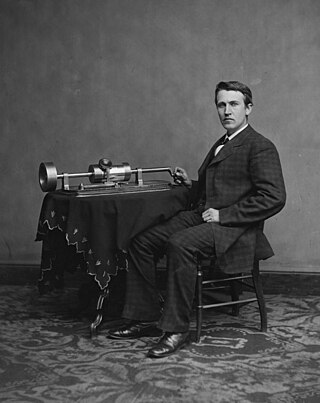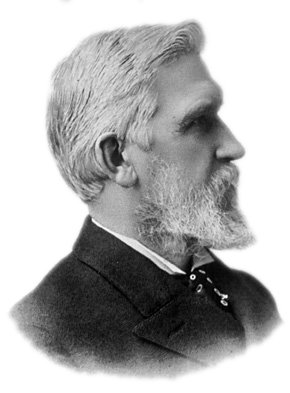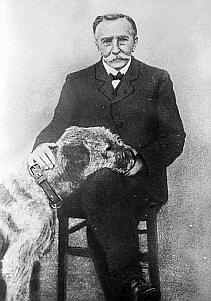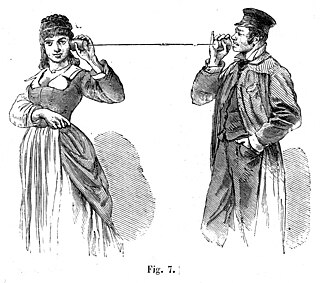
Alexander Graham Bell was a Scottish-born Canadian-American inventor, scientist and engineer who is credited with patenting the first practical telephone. He also co-founded the American Telephone and Telegraph Company (AT&T) in 1885.

A phonograph, in its later forms also called a gramophone or since the 1940s called a record player, or more recently a turntable, is a device for the mechanical and analogue recording and reproduction of sound. The sound vibration waveforms are recorded as corresponding physical deviations of a spiral groove engraved, etched, incised, or impressed into the surface of a rotating cylinder or disc, called a "record". To recreate the sound, the surface is similarly rotated while a playback stylus traces the groove and is therefore vibrated by it, very faintly reproducing the recorded sound. In early acoustic phonographs, the stylus vibrated a diaphragm which produced sound waves which were coupled to the open air through a flaring horn, or directly to the listener's ears through stethoscope-type earphones.

A telephone is a telecommunications device that permits two or more users to conduct a conversation when they are too far apart to be easily heard directly. A telephone converts sound, typically and most efficiently the human voice, into electronic signals that are transmitted via cables and other communication channels to another telephone which reproduces the sound to the receiving user. The term is derived from Greek: τῆλε and φωνή, together meaning distant voice. A common short form of the term is phone, which came into use early in the telephone's history.

The photophone is a telecommunications device that allows transmission of speech on a beam of light. It was invented jointly by Alexander Graham Bell and his assistant Charles Sumner Tainter on February 19, 1880, at Bell's laboratory at 1325 L Street in Washington, D.C. Both were later to become full associates in the Volta Laboratory Association, created and financed by Bell.

A microphone, colloquially called a mic, is a transducer that converts sound into an electrical signal. Microphones are used in many applications such as telephones, hearing aids, public address systems for concert halls and public events, motion picture production, live and recorded audio engineering, sound recording, two-way radios, megaphones, and radio and television broadcasting. They are also used in computers and other electronic devices, such as mobile phones, for recording sounds, speech recognition, VoIP, and other purposes, such as ultrasonic sensors or knock sensors.

Johann Philipp Reis was a self-taught German scientist and inventor. In 1861, he constructed the first make-and-break telephone, today called the Reis telephone. It was the first device to transmit a voice via electronic signals and for that the first modern telephone. Reis also coined the term.

Antonio Santi Giuseppe Meucci was an Italian inventor and an associate of Giuseppe Garibaldi, a major political figure in the history of Italy. Meucci is best known for developing a voice-communication apparatus that several sources credit as the first telephone.

Elisha Gray was an American electrical engineer who co-founded the Western Electric Manufacturing Company. Gray is best known for his development of a telephone prototype in 1876 in Highland Park, Illinois. Some recent authors have argued that Gray should be considered the true inventor of the telephone because Alexander Graham Bell allegedly stole the idea of the liquid transmitter from him. Although Gray had been using liquid transmitters in his telephone experiments for more than two years previously, Bell's telephone patent was upheld in numerous court decisions.

This timeline of the telephone covers landline, radio, and cellular telephony technologies and provides many important dates in the history of the telephone.

A tin can phone is a type of acoustic (non-electrical) speech-transmitting device made up of two tin cans, paper cups or similarly shaped items attached to either end of a taut string or wire.

The invention of the telephone was the culmination of work done by more than one individual, and led to an array of lawsuits relating to the patent claims of several individuals and numerous companies.

Sound recording and reproduction is the electrical, mechanical, electronic, or digital inscription and re-creation of sound waves, such as spoken voice, singing, instrumental music, or sound effects. The two main classes of sound recording technology are analog recording and digital recording.

The carbon microphone, also known as carbon button microphone, button microphone, or carbon transmitter, is a type of microphone, a transducer that converts sound to an electrical audio signal. It consists of two metal plates separated by granules of carbon. One plate is very thin and faces toward the speaking person, acting as a diaphragm. Sound waves striking the diaphragm cause it to vibrate, exerting a varying pressure on the granules, which in turn changes the electrical resistance between the plates. Higher pressure lowers the resistance as the granules are pushed closer together. A steady direct current is passed between the plates through the granules. The varying resistance results in a modulation of the current, creating a varying electric current that reproduces the varying pressure of the sound wave. In telephony, this undulating current is directly passed through the telephone wires to the central office. In public address systems it is amplified by an audio amplifier. The frequency response of most carbon microphones, however, is limited to a narrow range, and the device produces significant electrical noise.
The Elisha Gray and Alexander Graham Bell controversy concerns the question of whether Gray and Bell invented the telephone independently. This issue is narrower than the question of who deserves credit for inventing the telephone, for which there are several claimants.

This history of the telephone chronicles the development of the electrical telephone, and includes a brief overview of its predecessors. The first telephone patent was granted to Alexander Graham Bell in 1869.
Acoustic telegraphy was a name for various methods of multiplexing telegraph messages simultaneously over a single telegraph wire by using different audio frequencies or channels for each message. A telegrapher used a conventional Morse key to tap out the message in Morse code. The key pulses were transmitted as pulses of a specific audio frequency. At the receiving end a device tuned to the same frequency resonated to the pulses but not to others on the same wire.
A water microphone or water transmitter is based on Ohm's law that current in a wire varies inversely with the resistance of the circuit. The sound waves from a human voice cause a diaphragm to vibrate which causes a needle or rod to vibrate up and down in water that has been made conductive by a small amount of acid. As the needle or rod vibrates up and down in the water, the resistance of the water fluctuates which causes alternating current in the circuit. For this to work, the resistance of the water must vary substantially over the short distance the needle or rod vibrates. Acidulated water works well because only a small amount of acid is added. If one millimeter of acidulated water has a resistance of 100 ohms, two millimeters would have 200 ohms which would produce enough alternating current to transmit audio signals in thousands of feet of wire. Mercury will not work because the resistance of one millimeter of mercury is less than a tenth of an ohm and vibration of a needle in mercury would produce negligible alternating current.

The phonomotor or "vocal engine" was a device invented by Thomas Edison in 1878 to measure the mechanical force of sound. It converted sound energy or sound power into rotary motion which could drive a machine such as a small saw or drill. It derived from his work on the telephone and phonograph.
The Telephone Cases, 126 U.S. 1 (1888), were a series of U.S. court cases in the 1870s and the 1880s related to the invention of the telephone, which culminated in an 1888 decision of the U.S. Supreme Court that upheld the priority of the patents belonging to Alexander Graham Bell. Those patents were used by the American Bell Telephone Company and the Bell System, although they had also acquired critical microphone patents from Emile Berliner.
The following timeline tables list the discoveries and inventions in the history of electrical and electronic engineering.















